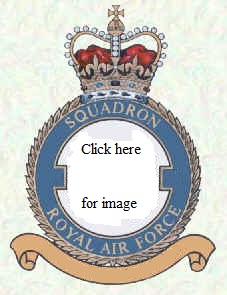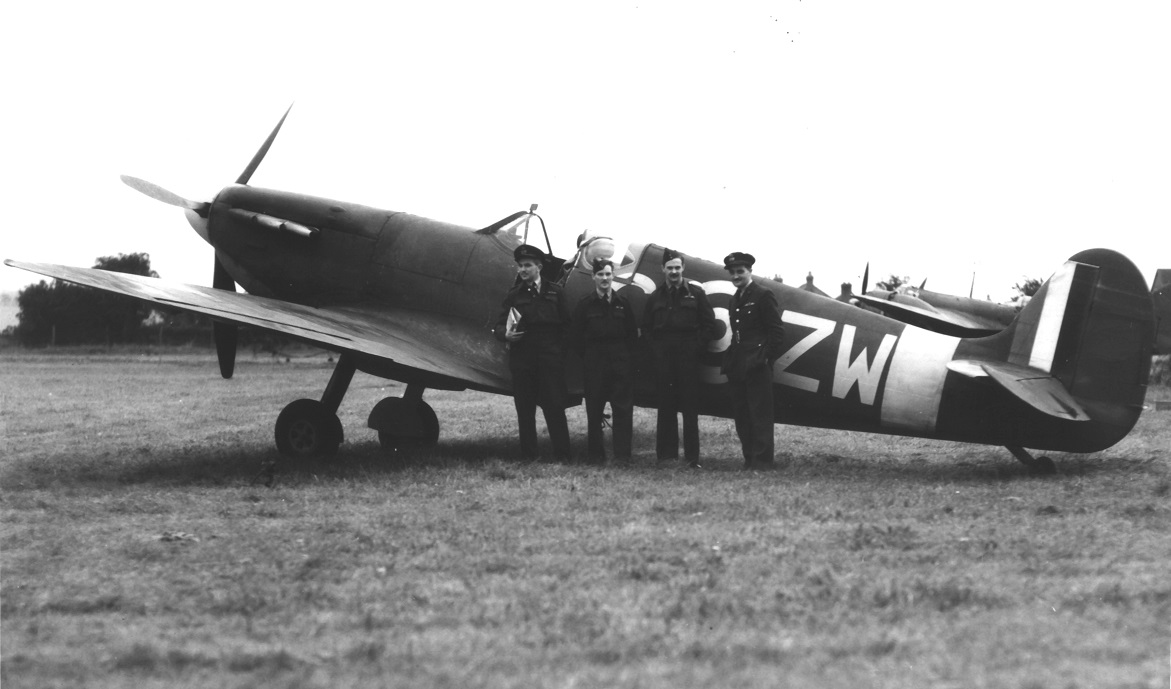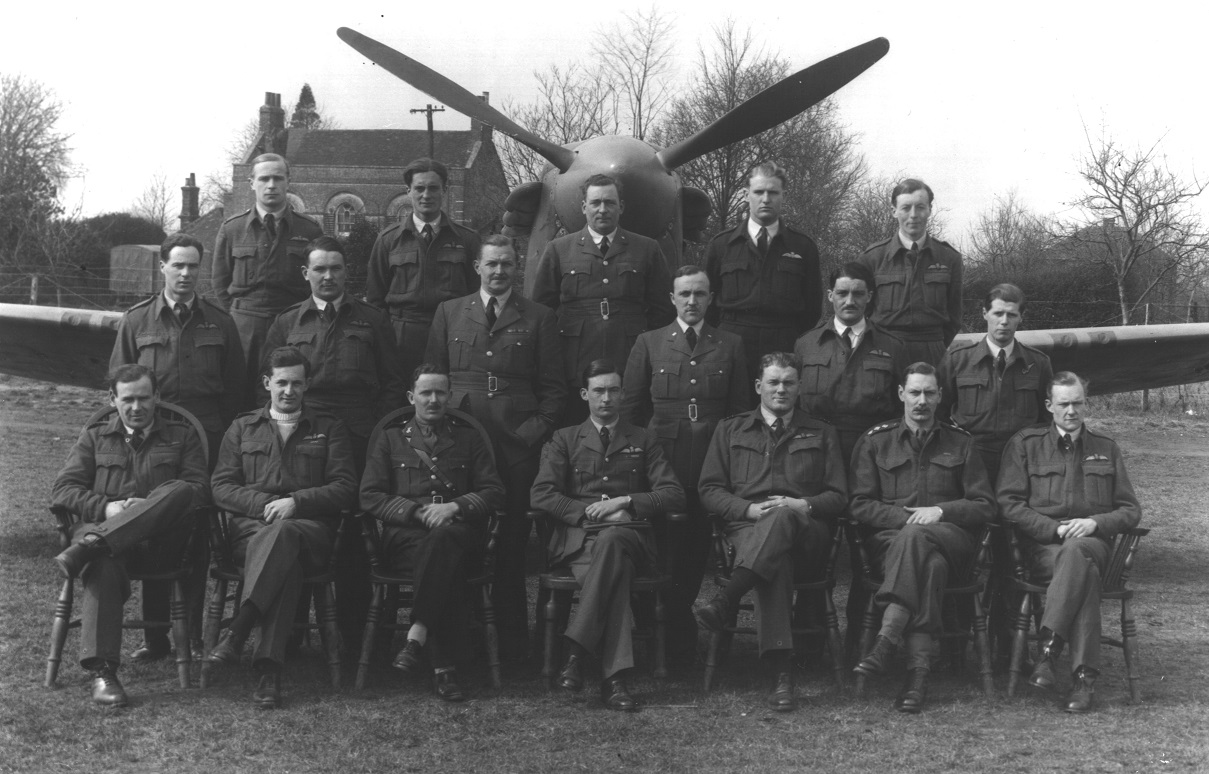Air of Authority - A History of RAF Organisation
No 136 - 140 Squadron Histories
 Formation
began on 1 April 1918 at Lake Down, as a training unit until September when it
would begin working up on DH9s for deployment to France in October, but it was
disbanded on 4 July 1918. Its re-formation was immediately rescheduled to
begin as a DH9A unit at the end of September for deployment in November, but
these plans were suspended on 29 July and cancelled on 17 August.
Formation
began on 1 April 1918 at Lake Down, as a training unit until September when it
would begin working up on DH9s for deployment to France in October, but it was
disbanded on 4 July 1918. Its re-formation was immediately rescheduled to
begin as a DH9A unit at the end of September for deployment in November, but
these plans were suspended on 29 July and cancelled on 17 August.
In World War Two, the squadron reformed at Kirton-in-Lindsay on 20 August 1941 as a fighter squadron equipped with Hurricanes. Beginning operations at the end of September, it was only operational until early November, when it was despatched to India. However, en-route its destination was altered to Burma as a result of the Japanese attack on the country, arriving in early February 1942. With the Japanese advance being so rapid and successful, it was necessary to withdraw the squadron back to India before the end of February.
Reformed the squadron provided air defence of the Calcutta area from March 1942, but in December it began operating detachments over the Burmese front and by the end of the month it moved to Chittagong to continue these operations. Returning to India in June 1943, it converted to Spitfire Vs in October and returned to the Burma front in December. In January 1944 the Mk Vs were replaced by VIIIs and in July the squadron moved to Ceylon. In March 1945 it moved to the Cocos Islands and remained there until the end of the war. From October 1945 to early May 1946, it re-located to Malaya, but whilst in transit back to India, the squadron was disbanded on 8 May by being renumbered No 152 Squadron.
.
Squadron Codes used: -
| XY | Allocated Apr 1939 - Sep 1939 |
| HM | Dec 1943 - May 1946 |
[Aircraft & Markings | Commanding Officers]
 Formation
began on 1 April 1918 at Shawbury, as a training unit until September when it
would begin working up on DH9s for deployment to France in November, but it was
disbanded on 4 July 1918. Its re-formation was immediately rescheduled to
begin as a DH9A unit at the beginning of October for deployment in early
December, but these plans were suspended on 29 July and cancelled on 17 August.
Formation
began on 1 April 1918 at Shawbury, as a training unit until September when it
would begin working up on DH9s for deployment to France in November, but it was
disbanded on 4 July 1918. Its re-formation was immediately rescheduled to
begin as a DH9A unit at the beginning of October for deployment in early
December, but these plans were suspended on 29 July and cancelled on 17 August.
The squadron was reformed on 20 September 1941 at Charmy Down as a Whirlwind fighter squadron. Operations began in October, but the following month it moved to Coltishall, from where it continued low-level Ramrods and Rhubarbs. In September 1942, the squadron's aircraft began being fitted with bomb racks and from October it began fighter-bomber operations.
Whirlwinds finally ceased operations in June 1943, when the squadron converted to rocket equipped Hurricane IVs and began anti-shipping operations with these in July. However, Hurricanes were a temporary measure and in January 1944, these were replaced by Typhoons, initially bomb equipped but replaced by rocket armed versions in April. The squadron was now part of No 124 Wing of 2nd Tactical Air Force and having participated in the preparations for D-Day, it covered the actual landings on 6 June 1944. However, instead of moving to France after the landing, it was retained in Britain until August to combat V-1 flying bombs being launched against Southern England.
Moving to France in August, the squadron provided ground attack support to 21th Army Group as it advanced through France, the Low Countries, Belgium and into Germany. After the war the squadron remained in Germany until August 1945, when it moved to Warmwell for an air firing course, whilst there, it was disbanded by being renumbered No 174 Squadron.
Squadron Codes used: -
| TS | Allocated Apr 1939 - Sep 1939 |
| SF | Feb 1941 - Aug 1945 |
[Aircraft & Markings | Commanding Officers]
 Initially
planned, in November 1917, to be a O/400 or DH9 unit, the time, equipment
and place of its planned formation being changed on a number of occasions before
these were all cancelled on 4 July 1918. Its formation was immediately
rescheduled to begin at Chingford on 5 August as a Bristol F2B unit. This
plan was also cancelled on 29 July but then the squadron actually formed on 30
September with its deployment planned for November. Although the squadron
received its equipment as planned the Armistice intervened and it never reached
France, disbanding on 1 February 1919.
Initially
planned, in November 1917, to be a O/400 or DH9 unit, the time, equipment
and place of its planned formation being changed on a number of occasions before
these were all cancelled on 4 July 1918. Its formation was immediately
rescheduled to begin at Chingford on 5 August as a Bristol F2B unit. This
plan was also cancelled on 29 July but then the squadron actually formed on 30
September with its deployment planned for November. Although the squadron
received its equipment as planned the Armistice intervened and it never reached
France, disbanding on 1 February 1919.
The squadron was reformed on 25 August 1941 when No 1419 (Special Duties) Flight was raised to squadron status at Newmarket. The squadron was immediately responsible for the supply dropping of arms, equipment and agents into occupied territory using Whitleys and the dropping off and collection of agents using Lysanders. The Whitleys were replaced by Halifaxes in October 1941 and in February 1941, the Lysander operations were taken over by No 161 Squadron.
In March 1942 the squadron moved to what would be its base for most of the war, Tempsford. Stirlings arrived in June 1944 and these had supplanted the Halifaxes by August. It was now carrying out supply drops to resistance forces throughout Europe and as far away as Poland and down into the Balkans and Austria. However, as the Allied armies got closer to Germany, the squadron's role became less in demand and on 9 March 1945 it was transferred to Bomber Command. Moving to Tuddenham, it re-equipped with Lancasters, operating as part of Bomber Command's Main Force for the rest of the war.
Retained as part of the post-war RAF, it continued to operate Lancasters until September 1947, when it re-equipped with Lincolns, but when other units Lincolns were being replaced by Washingtons, No 138 was not and it disbanded on 1 September 1950. The squadron reformed for the final time on 1 January 1955 at Gaydon as the RAF's first operator of the Vickers Valiant. These were taken in to action during the Suez Crisis of October 1956, but on 1 April 1962 the squadron disbanded.
Squadron Codes used: -
| WO | Allocated Apr 1939 - Sep 1939 |
| NF | Aug 1941 - Mar 1945, Apr 1947 - Sep 1950 |
| AC | Mar 1945 - Apr 1947 |
[Aircraft & Markings | Commanding Officers]
 Initially
planned, in November 1917, to be a O/400 or DH9 unit to form on 1 April 1918,
and remained in the planned programme until at least March 1918,
after which it disappeared from these plans. The number was
eventually brought
into use on 3 July 1918, when 'Z' Flight of No 34 Squadron at Villaverla in Italy was raised to
squadron status as No 139 Squadron, equipped with Bristol Fighters. It operated as a fighter-reconnaissance unit until the
end of the war, returning to Britain on 25 February 1919 and disbanding on the 7th
of the following month.
Initially
planned, in November 1917, to be a O/400 or DH9 unit to form on 1 April 1918,
and remained in the planned programme until at least March 1918,
after which it disappeared from these plans. The number was
eventually brought
into use on 3 July 1918, when 'Z' Flight of No 34 Squadron at Villaverla in Italy was raised to
squadron status as No 139 Squadron, equipped with Bristol Fighters. It operated as a fighter-reconnaissance unit until the
end of the war, returning to Britain on 25 February 1919 and disbanding on the 7th
of the following month.
The squadron reformed as a light bomber unit at Wyton on 3 September 1936, equipped with Hinds. Re-equipping with Blenheim Is in July 1937 and then IVs in September 1939, it carried out the first RAF operation of World War Two, a reconnaissance of the German fleet in Wilhelmshaven. At the end of 1939, it moved to France, beginning attacks against enemy columns as soon as the Geramn invasion began on 10 May 1940. However, casualties in these operations were very heavy in less then two weeks the squadron was withdrawn to West Raynham to recover and re-equip.
Having re-equipped the squadron began attacks against enemy ports and airfields as part of No 2 Group and continued these until December 1941. During this period it rotated between Horsham St Faith and Oulton, except for two detachments, May-June 1941 to Malta and August -September 1941 at Manston. In December 1941 the squadron was despatched to the Far East. Arriving in Burma in February 1942, it was equipped with Hudsons and allocated to the general reconnaissance role. However, it was soon involved in operations against the Japanese and on 30 April was renumbered as No 62 Squadron.
It reformed back at Horsham St Faith on 8 June 1942 as a Blenheim V unit, once again being part of No 2 Group of Bomber Command, but before becoming operational on these, it re-equipped with Mosquitoes. It was only the second RAF unit to operate the type and it was soon carrying out daring low-level raids over occupied territory and Germany itself. In July 1943, the squadron was transferred to No 8 (Pathfinder) Group where it was used to precede raids dropping Window to confuse enemy radar operators. Its Mosquitoes were later equipped with H2S and it operated as a blind marking unit until the end of the war.
Retained as part of the post-war RAF, it continued to operate Mosquitoes until re-equipping with the Canberra in 1953 at Hemswell before moving to Binbrook in December 1955, where it disbanded on 31 December 1959. The squadron reformed for the last time, so far, on 1 February 1962 when the Intensive Trials Unit for the Victor at Wittering was renumbered, thereby becoming the RAF unit to operate the Victor as part of the V-Force. It finally disbanded on 31 December 1968.
| Standards | Battle Honours* |
| Award
of Standard
originally announced on 26 Nov 1963 , effective from 1 Apr 1963 but presented:-
? |
Vittorio Venito: Italian Front & Adriatic, 1918: France & Low Countries, 1939-40: Channel & North Sea, 1940-41: Fortress Europe, 1940-44: Invasion Ports, 1940: German Ports, 1941-45: Biscay Ports, 1941-45: Eastern Waters, 1942: Berlin, 1943-45: Ruhr, 1943-45: France & Germany, 1944-45: |
Squadron Codes used: -
| SY | Apr1939 - Sep 1939 |
| XD | Sep 1939 - Mar 1942, Jun 1942 - 1951 |
[Aircraft & Markings | Personnel, aircraft and locations | Commanding Officers]
 Initially
planned, in November 1917, to be a O/400 or DH9 unit, to form on 1 April 1918,
and although it remained in the planned programme until at least March 1918,
after that it disappeared from these plans and therefore the squadron form
during World War One.
Initially
planned, in November 1917, to be a O/400 or DH9 unit, to form on 1 April 1918,
and although it remained in the planned programme until at least March 1918,
after that it disappeared from these plans and therefore the squadron form
during World War One.
The squadron eventually formed on 17 September 1941 as a Spitfire and Blenheim equipped photo-reconnaissance unit at Benson, when no 1417 Flight was raised to Squadron status. The Spitfires were used for daylight operations over Northern France and later the Low Countries and Belgium, whilst the Blenheims were used for night reconnaissance using flares.
The Blenheims were supplemented by Venturas in February 1943 and by August the Blenheims had left. In July 1943 the squadron was allocated to No 34 Wing of 2nd Tactical Air Force and its main operations now centred on the preparations for the forthcoming invasion. In November 1943, it began to receive Mosquitoes and with the Venturas leaving in January 1944 and the last Spitfire in April, it became wholly equipped with Mosquitoes. These continued to be used in both day and night roles for the remainder of the war, having moved to Belgium in September 1944. The squadron returned to Britain in September 1945 and disbanded at Fersfield on 10 November 1945.
.
Squadron Codes used: -
| RM | Allocated Apr 1939 - Sep 1939 |
| ZW | Aug 1941 - Feb 1942 |
 |
| A Spitfire of No 140 Sqn Spitfire at RAF Benson. Gordon Green DFC on right. |
 |
| Officers of No 140 Sqn Spitfire at RAF Benson
March/April 1942 Photos courtesy - Michael Prendergast and RAF Benson's Ethos and Heritage Facility |
[Aircraft & Markings | Commanding Officers]
Squadron badge image on this page is courtesy of Steve Clements
© Crown Copyright is reproduced with the permission of the Directorate of Intellectual Property Rights
This page was last updated on 29/03/21©
![]() Organisational Index
Organisational Index ![]()